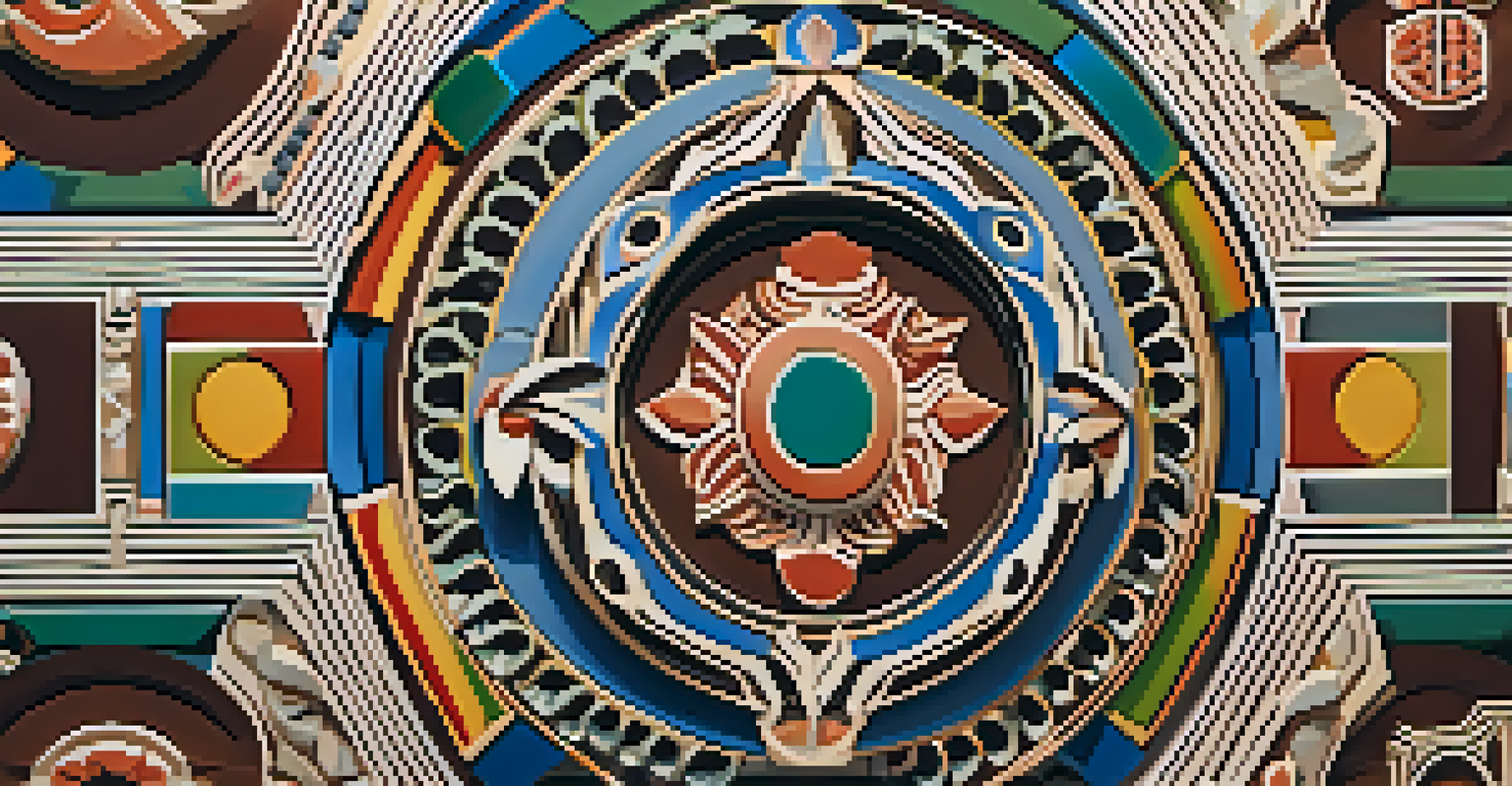Cultural Carving Techniques That Influence Graphic Design

Understanding Cultural Carving Techniques in Design
Cultural carving techniques are not just art forms; they are rich narratives that express the identity and beliefs of a community. From totem poles of Indigenous peoples to intricate Asian woodblock prints, these techniques tell stories through shapes and symbols. Graphic designers often draw inspiration from these methods, transforming ancient artistry into modern visuals.
Art is a way of communicating and expressing the values of a culture, and carving is a vital part of that language.
By understanding the history and significance behind these carvings, designers can create work that resonates on a deeper level. For instance, a logo inspired by Native American patterns can evoke a sense of heritage and authenticity. This connection between the past and present enhances the emotional impact of modern design.
Moreover, incorporating these techniques can also promote cultural appreciation and awareness. When designers respect and adequately represent these traditions, they not only enrich their own work but also share diverse narratives with a broader audience.
The Role of Texture in Carving and Graphic Design
Texture plays a crucial role in both carving techniques and graphic design. In carving, the physical texture of materials such as wood, stone, or clay adds depth and tactile quality to the artwork. Similarly, in graphic design, texture can create visual interest and evoke emotions, making the design more engaging.

Designers often mimic the texture found in traditional carvings by using digital tools to replicate patterns and surfaces. For example, a designer might use a gritty texture to evoke the ruggedness of stone carvings, thereby enhancing the overall aesthetic. This technique not only draws inspiration from cultural heritage but also captivates the viewer's attention.
Cultural Techniques Enhance Design
Incorporating cultural carving techniques allows designers to create work that resonates emotionally and promotes cultural appreciation.
Furthermore, using texture can help tell a story or convey a message. A smooth, polished finish might suggest elegance, while a rough, uneven surface could symbolize authenticity and tradition, providing an interactive experience for the audience.
Color Symbolism in Carving and Graphic Design
Color holds significant meaning in various cultures, especially in traditional carving techniques. Each hue can represent different emotions, beliefs, or spiritual concepts. For instance, red may symbolize strength and vitality in many Indigenous cultures, while blue can signify tranquility.
Design is not just what it looks like and feels like. Design is how it works, and respecting cultural narratives enhances that functionality.
Graphic designers can harness this power of color to create designs that resonate with specific audiences. By understanding the cultural meanings behind colors, designers can make informed choices that enhance their work's message. A logo incorporating these colors can thus connect with viewers on a more profound emotional level.
Additionally, blending colors inspired by traditional carvings can create a unique visual language. This approach not only honors the original art form but also invites a fresh perspective in modern design, bridging the gap between cultures and time periods.
Patterns and Motifs in Cultural Carvings
Patterns and motifs are integral to carving techniques, often telling stories or representing cultural beliefs. These designs can be geometric, organic, or narrative-based, each carrying its significance. For graphic designers, these patterns can serve as an endless source of inspiration.
Incorporating traditional patterns into modern graphics can create a striking visual impact. For example, using African tribal patterns in a contemporary poster can add depth and interest, while also paying homage to a rich cultural history. This fusion of old and new can make graphic designs more compelling.
Texture Adds Depth to Designs
The use of texture in both carving and graphic design enhances visual interest and can convey deeper messages to the audience.
Moreover, patterns can enhance brand identity when used thoughtfully. A company that utilizes specific motifs in its branding can establish a strong connection with its target audience, reflecting values and cultural appreciation.
Cultural Narratives Influencing Graphic Design Choices
Every carving has a story, and these narratives often influence the design choices artists make. By understanding the context behind these cultural symbols, designers can create visuals that resonate with their intended audience. For instance, a design inspired by Maori carvings might reflect themes of community and connection.
This storytelling aspect can be woven into graphic design, making the work more relatable and meaningful. A designer might choose to incorporate local legends or myths into their visuals, enriching the viewer's experience. This approach not only elevates the design but also honors the culture it draws from.
Furthermore, cultural narratives can help brands differentiate themselves in a crowded market. A unique story behind a design can attract attention and foster a deeper connection with consumers, leading to increased loyalty and recognition.
The Impact of Carving Techniques on Typography
Typography is a vital element of graphic design, and its roots can often be traced back to traditional carving techniques. The way letters and symbols are carved into materials like wood or stone has influenced modern typefaces and font designs. Designers can draw on these techniques to create custom type that reflects cultural heritage.
For instance, a typeface inspired by ancient Egyptian hieroglyphs can evoke a sense of history and intrigue. By using these influences, designers can craft unique typographical styles that stand out and convey specific messages. This creative twist not only enhances the design but also pays tribute to its origins.
Ethics and Sustainability Matter
Designers must consider sustainability and ethical practices when utilizing traditional carving techniques to respect both the environment and cultural communities.
Moreover, the tactile nature of carved letters can inspire designers to experiment with textures and effects in digital typography. By blending traditional carving aesthetics with modern technology, designers can create visually stunning and culturally rich lettering.
Sustainability and Ethical Considerations in Design
As graphic designers explore cultural carving techniques, sustainability and ethics become essential considerations. Many traditional carving practices utilize natural materials, which can inspire modern designers to prioritize eco-friendly options. This approach aligns with the growing demand for sustainable design in the industry.
By sourcing materials responsibly and respecting cultural traditions, designers can create work that honors both the environment and the communities they draw from. This commitment to ethical practices not only enhances the integrity of the design but also fosters positive relationships with cultural groups.

Moreover, sustainable design encourages innovation, as designers seek new ways to incorporate traditional techniques without compromising the environment. This fusion of creativity and responsibility can lead to fresh perspectives and groundbreaking designs that resonate with conscious consumers.